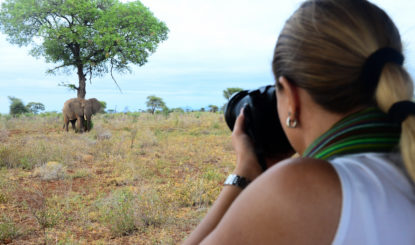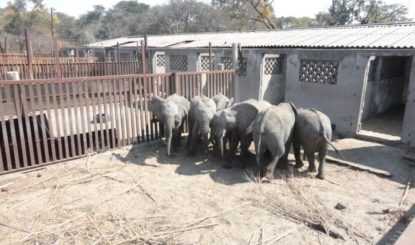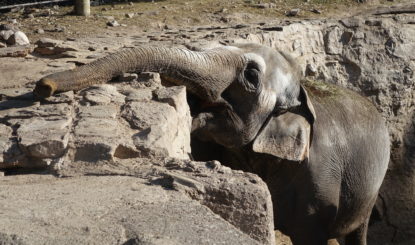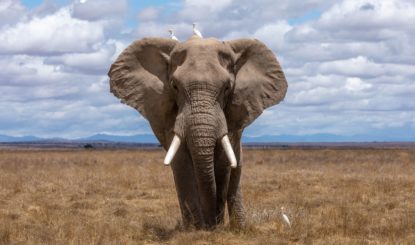The Lives of Elephants
Quiet, nearly silent, footfalls with just a whisper of contact with the sand; a group of elephants moves single-file and purposefully along a well-trodden path. The multiton giants step swiftly but always carefully, their footprints in a surprisingly narrow line for an animal of such immense size, their body weight skillfully balanced above pillars of strong bone.
Eating, drinking, sleeping – the essential tasks for a life in the wild
Feeding an enormous metabolic furnace, their perpetual foraging takes them from one locality to another, traveling an average of 10km for up to three-quarters of every day in the search for the best parts of the most abundant plants. Leaves of succulent green or drying yellow grass, vines, herbs and flowers, fruits in season, twig tips of shrubs, bark from favoured trees, stems, roots… all available and necessary in different places at different times of year. Plucking, tearing, snapping, shaking, all require the deployment of trunk or tusk or foot, separately or in combination, to pick and process the multitude of different food items.
Elephants need a lot of food, but they also need to drink, daily or at least every other day. And they also need essential minerals, as well as places for wallowing and cooling, and resting. They manage to find time to doze for an hour or two during the hottest part of the day, and to lie down to sleep for a few hours between midnight and dawn, and there are often preferred places to take these rest breaks. They search widely for the best resources when conditions allow, as during rainy months, when food and water is widespread. As water supplies dwindle and vegetation desiccates, they become more conservative. By the end of dry seasons, they are concentrated within a few kilometers of perennial water sources.
The gardeners of Africa
As with any animal, their foraging removes parts from plants. Due to vast amounts consumed, this foraging has the effect of changing, opening up, diversifying the structure of plant communities, which have knock-on effects on the habitats for other animal species. The seeds of many plant species are carried off by elephants and planted in a rich compost of dung. For some species it is only elephants that perform this function. They are truly the architects of African savannas and forests; keystone species whose presence or absence has cascading effects on the other plants and animals.
Elephant memory
For an elephant, there is a lot to know about food and other resources, and this knowledge is built up over a lifetime. The oldest animals in the social groups remember where to find the best food in specific times and conditions, and lead their followers through the world, passing on this information as they go.
Close social relationships, highly developed senses
Their noiseless pathfinding is broken only when they rumble to each other to maintain contact, or to indicate their intention to move on. Or with greater volume, when they are reunited with a close acquaintance they have been missing for the days of their separation. At such times, the air can be filled with trumpets and deep rumbles as they express their joy in meeting up. In times of dispute, offended blasts may be heard, and warnings may be given at frequencies below those of human hearing. Calves are more vocal: they squawk and squeak and honk. The calls have high and lower frequency elements, again some below the level of human hearing. These calls may carry for many kilometres, and may be accompanied by seismic vibrations that propagate through the ground. Elephants can recognize the calls of relatives, friends, acquaintances, enemies and strangers – playback experiments have revealed a knowledge of some hundreds of different individuals. It is likely that elephants have a good idea of where many of their absent companions are, just by hearing and monitoring their long-distance sounds.
Elephants’ sense of smell is possibly even more acute than their hearing. With trunks trailing on the ground, they are constantly coming across the trails of scent laid down in their environment by other species that share it with them and other elephants that have passed by earlier. When they do meet up, encounters and greetings typically include extending the trunk to smell the other, their mouths and other openings, to reacquaint themselves, and to learn the latest news about the food being eaten or the body condition of their neighbours. Males sample the urine of females they visit to assess the pheromones that indicate their stage of reproductive cycling, and females get similar information about the males. Thus elephants have a continuous awareness of the world of odours that complements their audio landscape, much more than their more limited vision can offer.
Matriarchat and single males
The society of elephants actually consists of two different camps of separate sexes whose lives overlap. The females stay together from birth, while the males come to form looser though often consistent associations with other males, joining female groups only from time to time. Females live with their sisters, mothers, aunts and cousins remaining close, as well as friends who may come together through mutual interest or respect, or in times of need when their family members die and they are left alone. Males live in different areas, spending most of their time feeding or jousting in semi-serious tests of strength. As they get older, they join females only when interested in mating.
A family affair
Calves are born after a 22-month gestation, and greeted with trumpets and dancing. They struggle to their feet and walk almost as soon as they emerge, joining the ever-mobile world of their families. They are attended by their mothers, but also older sisters, aunts, cousins, who keep them safe from hazards, such as predators, uneven ground and water risks, while patiently responding to their playfulness and urge to explore other elephants and their surroundings. This “allomothering” gives mothers a break, but is also a learning opportunity for the younger females, a school for practicing the care of their own calves when their time comes. An elephant grows up in an environment that is both safe and stimulating, as they are guided gradually towards adolescence and later adulthood. They gain the skills in feeding and navigating elephant society that they must learn in order to survive and prosper; without this learning of life skills and the details of their local environment, they would struggle. If a mother elephant dies and leaves a young calf within its first two years of life, the youngster is likely to die from lack of maternal milk – elephants’ cooperation rarely extends to the suckling of young other than their own. But calves older than two years may survive if the rest of the family is intact, as the older juveniles and related adults can step in to help them.
Families, if fortune favours them, grow larger over the years. They are tightly bonded, but get to the point where differing priorities or feeding competition cause them to split up along mother-daughter lines, especially during dry periods. In times of abundance, they re-join in families and extended families, as well as with friendly unrelated families. Huge aggregations with tens of families and hundreds of individuals may be seen in the good times of rainy seasons. In dry periods, they become concentrated near rivers or waterholes.
The behaviour of males and female juveniles begins to diverge from an early age. Young males stray farther and farther from their mothers, engaging and experimenting in cooperative play and tussling with others. When families meet each other in larger gatherings, the males are first to explore the other juveniles. As they approach their early teens, males begin to spend more and more time in independent movement, apart from the family. At this stage, and sometimes with a shove from the older females, they become independent and join the life of bachelor bulls.
Males and their hormones
Adult males live apart from the families for much of the year, concentrating on feeding and building up reserves of energy. When they are fit, and especially during the rains, they enter into a condition termed “musth”, when the levels of male sex hormone, testosterone, skyrocket, and aggression replaces friendly camaraderie for some weeks or months. Males in musth stride ostentatiously around, dribbling pungent urine trails (with chemicals advertising state of readiness for anything), and searching for females who are in estrus. The females want to be found by these males within their short, week-long period of ovulation and they gather in large groups. When musth males encounter other males, they bully them out of the way. If two musth bulls come into contact, they spend much time assessing each other. Eventually, however, there may be a fight for mating rights, sometimes with a fatal outcome.
Natural – and much less natural – mortality
If an elephant has done well enough to survive to old age, they may find that their last set of teeth can no longer grind the coarse vegetation they consume in bulk. They gradually run out of energy and die in a peaceful old age. In African elephants, this can happen in their 60s. However, if there are extreme food shortages, as in droughts, there can be a lot of mortality. It hits the youngest calves, especially those still dependent on mother’s milk the hardest, and they are the first to succumb. In a particularly severe drought, even juvenile and adult animals may die, when there is insufficient food within a day’s foraging range from water. While distressing, these deaths occur naturally and serve as one form of population limitation. Elephants may also disperse from areas of high density, leaving the core areas in search of better opportunities elsewhere. Many die in this colonization attempt, but those that are successful find a new habitat.
Other elephants die from occasional disease outbreaks. Their worst enemy, however, is the ivory trade, at the hand of man. When elephants encounter the body of a dead elephant, especially a relative, they become serious and solemn. They stand quietly with the carcass, often touching the bones and moving them gently. They have been known to cover them with branches or other vegetation. It is clear that they are deeply moved.
Intelligent and sensitive creatures
Although in many ways they are very different creatures from us, they show many similarities that are common to intelligent, sociable and complicated animals, including the emotions of joy and sorrow, and the ability to solve problems and remember solutions.
Due to the structure of their society, the close social relationships they form and their reproductive requirements, every elephant poached, every elephant calf snatched from its family, is a disaster for the entire herd and thus a threat to the survival of the species. Ecosystems are also threatened as the African elephants gradually disappear.
The elephants are a nation that lives alongside us, and we must strive to understand them and their needs so that we can continue to coexist. Otherwise, they could be extinct in just one to two decades.
FFW project pages on elephant protection:




